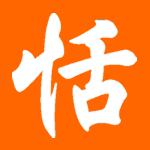Reader Aylwin Lo from Ottawa, Ontario, Canada has sent in these photos of a painting displayed in a framing store called "Images on Bank":
"Tian, I look forward to seeing your analysis. My goodness, those are some hideously-written characters... Thanks for keeping up the site. Very valuable stuff!"
Hideous? Indeed!
For the longest time, I could not figure out what the last two characters were due to the "artist"'s very poor hand writting. Eventually with help from Ken L, Brendan, and Rex, we finally figured out it says:
人有知學則有力矣
The quote was originally by 王充. It is the equivalent of 知識就是力量 or "knowledge is power".
Wang Ch'ung (or Wang Chong) (27–97 C.E.) was a Chinese philosopher during the Han Dynasty who developed a rational, secular, naturalistic, and mechanistic account of the world and of human beings. His main work was the Lun-Heng (first translated in 1911 as Balanced Enquiries, and since as Fair Discussions, or Critical Essays). (wikipedia)
百聞不如一見 (or in Japanese 百聞は一見に如かず)
It is translated as "Hearing it a hundred time is not equivaluent to seeing it once" or "A picture is worth a thousand words".
The giant character in the middle is 福, which means "good fortune".
I wonder how much this painting is priced at.


It might be worth noting that this was written (poorly!) with simplified characters. Here's a comparison:
ReplyDelete人有知學則有力矣
人有知学则有力矣
百聞不如一見
百闻不如一见
Admiration! You recognized such uglily written characters.
ReplyDeleteI thought the upper line as 人有知觉则有猴 and 猫 in the center the first sight on the first picture.
How in the world did you make the center character out to be 福 ? Taken from context? (I'm not doubting you, since I'm near 100% ignorant of the language. It's just amazing to me: the entire right side looks almost completely different. I thought that my handwriting was bad...)
ReplyDeleteOf course, it is technically possible that the original at the bank was also this bad, and that this painting is an accurate copy. (Not highly likely, though ;-) )
Max is right! This was written poorly. Tian, I know you've sent me the pics but I just couldn't figure out what it was written! Perhaps I was just too tired lately. :P
ReplyDeleteAnd to respond to Ivan's question. . . Yup, it was 福. You have to know something about the Chinese Calligraphy to read that word.
If you want to know more about Chinese Calligraphy, you can follow this link: http://www.chinapage.com/callig1.html
And I thought Wang Chung was just a great 80's band.
ReplyDeleteTo clarify, this painting wasn't at a bank. The "Bank" in "Images on Bank" refers to Bank St.
ReplyDeleteWhoof. I'd guessed that the next-to-last character was 才, Way off there.
ReplyDeleteIvan - The center character is recognizable as 福 for a couple of reasons - mainly, the right-hand-side, which usually can be recognized no matter how cursive the handwriting is, but also the fact that it, along with 寿, is one of the most commonly-calligraphed characters out there, so it's always a pretty safe bet.
A little update - The painting is no longer in the window, as of yesterday. Forgot to mention that. So I can't find out the price if it, alas!
ReplyDeleteYes, Wang Chung was a brilliant philosopher, who managed to extend his talent to performing 80's hits.
ReplyDeleteWang Chung was a British new wave musical group.
ReplyDeleteOriginally called Huang Chung from the Chinese for "perfect pitch" (though they later claimed it was the sound a guitar made on American Bandstand), the band formed in 1980. The lineup consisted of vocalist/guitarist Jack Hues, bassist Nick Feldman and drummer Darren Costin.
In 1984, having changed ther name to Wang Chung (supposedly to make pronunciation easier for English-speakers), they released Points on the Curve, which yielded two major hits, "Don't Let Go" (#36 US) and "Dance Hall Days" (#16 US).
Wang Chung, the band
Alright, alright. You get it!
ReplyDelete百聞不如一見 could also be roughly translated as "seeing is believing", I suppose.
ReplyDeleteAnd if "huang chung" means "perfect pitch", I'd love to see the characters. I once saw the band's name translated into Chinese as "yellow clock".
Everybody Wang Chung tonight!